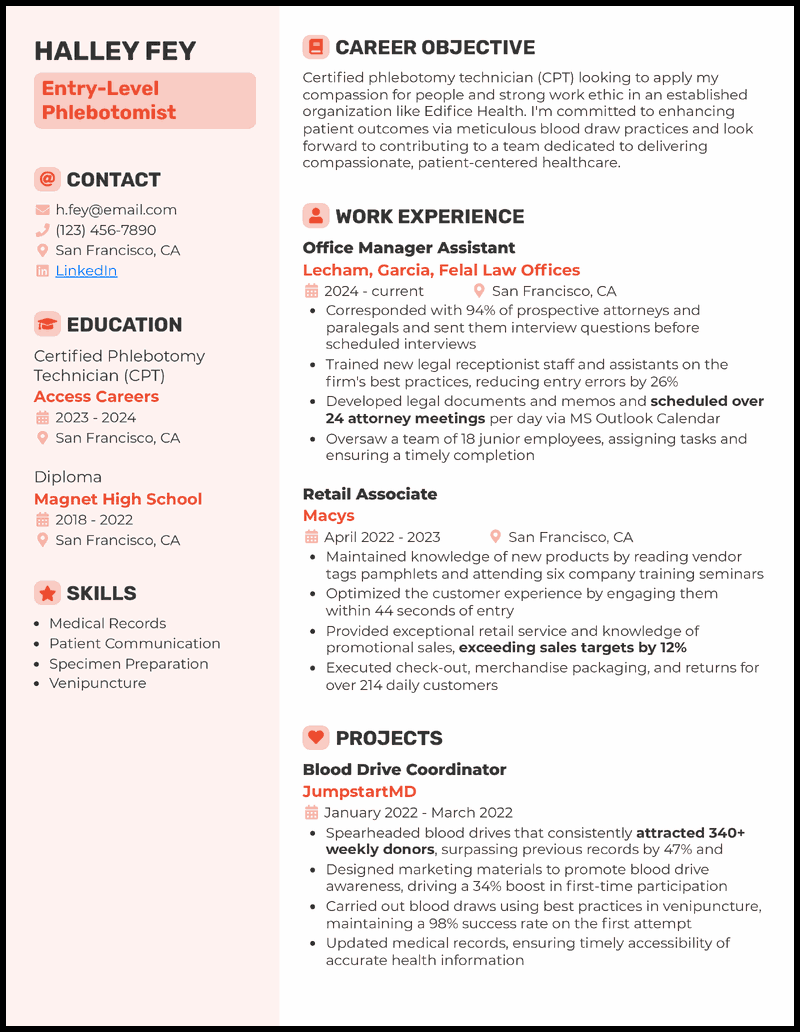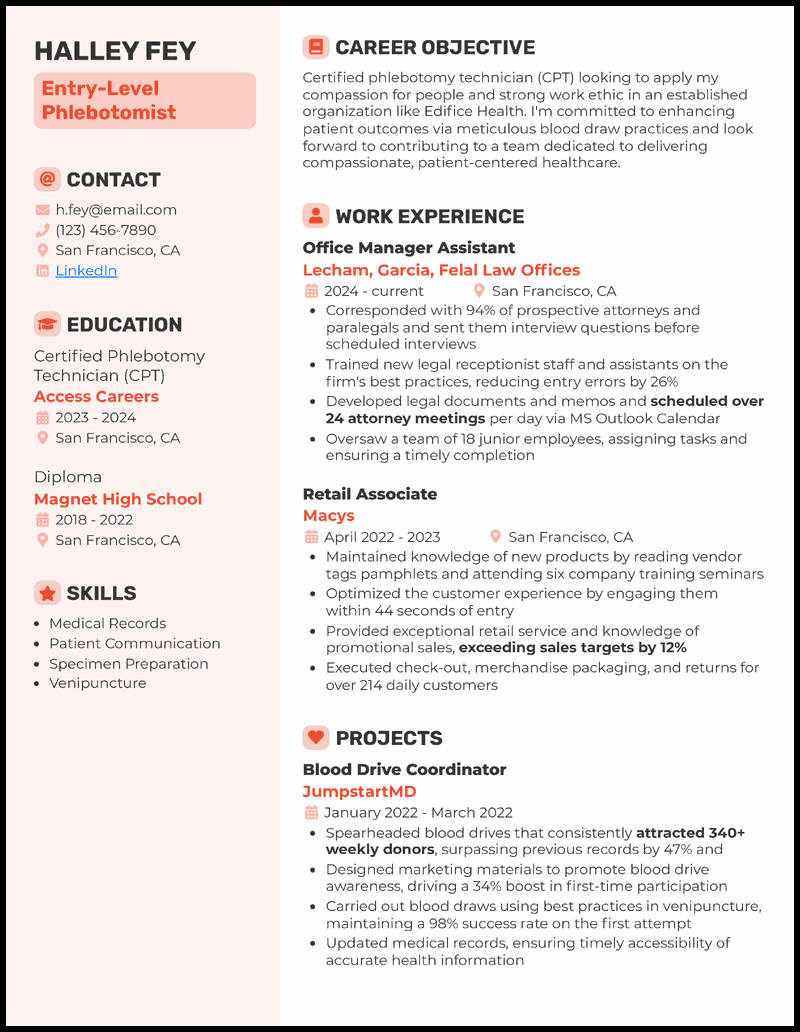If you’re applying for your first phlebotomy role, treat your resume not as a list of skills but as your first clinical impression.
To stand out, you’ll need to strategically highlight your training, niche certifications, and patient-facing strengths, tailor your skills for each job, and don’t forget to make a cover letter that reinforces your strengths and personality.
This guide covers:
- ↪ 5 entry-level phlebotomist resume examples that actually get interviews
- ↪ Essential sections to include and how to write each one like a pro
- ↪ How to tailor your resume to outmatch more experienced candidates
Why this resume works
- Start your entry-level phlebotomist resume by customizing your career objective to convey your goals and aspirations to the hiring managers. Rather than having the same old bleak career objective by stating the obvious, go the extra mile to use that space to showcase your abilities and excitement for the role.
Related resume examples
How to Write an Entry-Level Phlebotomist Resume

Getting into a phlebotomist career means having technical precision, strong communication skills, and a calm, patient-first attitude. While college may have helped you gain practical knowledge, it’s important to convey that same level of confidence on your resume.
Summary
Break into phlebotomy with confidence by drawing out your best projects, clinical skills, and certificates.
Whether it be drawing blood, preparing samples, or even compiling reports, you need to prove that you’re ready to do them all? Eager to know how you can put it all together?
This guide will cover everything you need to know about writing a strong phlebotomist resume.
Before we begin, let’s list down your resume’s most important sections for this role:
- Contact Information
- Education Qualifications
- Career Objective
- Work Experience/Projects

Make the perfect first impression with your contact information
Apart from your blood type (you’ll get plenty of them to deal with), list down your basic details and avoid unprofessionalism like including nicknames or spare email addresses. The example below shows how you can format this part:
Example
Halley Fey
Entry-Level Phlebotomist (Include the job title if your template allows)
(123) 456-7890
San Francisco, CA
LinkedIn (if you have one)

Leverage your transferable skills to gain competitve advantage
Entry-level phlebotomy candidates often struggle with listing skills on their resumes when they haven’t had on-the-job experience.
Think back to what you learned during your phlebotomy certification. Most of the topics covered will be the leading industry skills medical organizations seek, like selecting puncture sites and applying tourniquets.
Additionally, you can apply skills you’ve gained from other work experience. If you’ve been in positions where you provided customer service or completed data entry, those will apply to regular phlebotomy tasks when working with patients and organizing medical records.
Here are some of the most popular entry-level phlebotomist skills that medical facilities look for on resumes.
9 most popular entry–level phlebotomist skills
- Customer Service
- HIPAA Policies
- Puncture Site Selection
- Tourniquet Application
- Medical Records
- Sanitization
- Puncture Site Warming
- Blood Sample Handling
- OSHA Standards

Confidently present achievements from relevant experiences
Entry-level applicants often wonder, what examples of work experience do I list if I haven’t worked as a phlebotomist before?
Organizations will want to know how you’ll perform on the job. However, you can pull experience from many different areas. If you’ve provided customer service in a retail environment, your high satisfaction scores would still translate to phlebotomy.
You can also use the experiences you gained from your phlebotomy certification courses. If you performed lab analysis projects or scored high on tests for blood-collecting techniques, those examples still show a great deal of skill.
Here are a few samples:
- Greeted and provided friendly service to an average of 38 customers per day, resulting in 98% positive satisfaction scores.
- Conducted lab analysis in certification courses, successfully identifying 99% of all blood-borne pathogens.
- Performed data entry for an average of 80 daily orders with 99% accuracy.
- Sanitized all services and followed OSHA protocols when working in the kitchen at a nursing home to maintain Grade-A health inspection scores.

Add your education and certifications
While phlebotomy may not require a degree at the moment, you can always include your high school diploma and a healthcare training program, which demonstrates your skills in this field.
The most common education program candidates add for phlebotomy is a Certified Phlebotomy Technician (CPT) course, but you can mention whatever you’ve done, too.
When it comes to certificates, try including ones like:
- Basic Life Support (BLS)
- Certified Medical Assistant (CMA)
While technically, the CPT course is also a certification program, it’s the highlight, so list it separately in your education section.

Use your career objective as a quick snapshot of your enthusiasm
A resume or career objective is useful for entry-level candidates who’ve just begun their journey in phlebotomy. It doesn’t have to be anything fancy either. As long as you personalize it to the clinic/hospital you’re applying to, it will bring out your passion for the field.
We’ll share Halley’s objective to give you an idea of how to write one:
Example
Certified phlebotomy technician (CPT) looking to apply my compassion for people and strong work ethic in an established organization like Edifice Health. I’m committed to enhancing patient outcomes via meticulous blood draw practices and look forward to contributing to a team dedicated to delivering compassionate, patient-centered healthcare.

Bring out all your healthcare projects/internships (needles included)
Even without years on the job, your training, internships, and class projects prove you’re prepared for real-world phlebotomy:
Clinical Volunteering/Internships
- Describe the type of setting i.e., hospital, outpatient clinic, or diagnostic lab).
- Highlight technical skills (venipuncture, specimen labeling, infection control).
Personal or Training Projects
- Blood collection simulations (number of successful venipunctures completed).
- Lab-based projects (accuracy in specimen handling, testing procedures).
As a rule of thumb, make sure you quantify all of these experiences. If needed, try using a bullet point generator to craft impactful points.
Top 5 tips for your entry-level phlebotomist resume
- Always proofread before submitting
- When you must select puncture sites and manage records with top-notch accuracy, hiring managers will look for detail-oriented candidates from the beginning. Ensure you impress with a resume free of grammatical errors.
- Include a measurable impact
- Your examples should use numbers whenever possible to showcase the impact you had. That could include metrics like achieving 97% positive customer satisfaction scores or a 98% overall grade on your blood sample handling assessments.
- Aim for a full page of relevant information
- Entry-level candidates can struggle with this, but aim to fill up a full page with your experiences. You can fill in with hobbies & interests, education, or a resume objective to include more information. For instance, if you volunteered at a nursing home, that still provided you with great skills in patient care.
- Emphasize interpersonal and technical abilities
- Phlebotomy is a profession where you’ll want to ensure all patients are comfortable when you’re performing technical procedures. Therefore, any examples where you performed technical and interpersonal skills simultaneously, like data entry while explaining details to customers, will help you stand out.
- Action words are more engaging
- You can make your examples stand out using action words like “assisted” or “performed.” For instance, you could say you “assisted 27 customers daily to help them find in-store products while answering any questions they had.”

Key takeaways
- Prioritize soft skills like empathy and attention to detail
- Lead with certifications and clinical training
- Quantify experience, even from school or externships
- Keep formatting clean, consistent, and scannable
- Don’t skip the cover letter—use it to show personality
Entry-Level Phlebotomist Resume FAQs

Entry-level phlebotomy candidates will benefit from a resume objective. You could write a few sentences on how you’re a caring professional with three years of experience assisting patients in nursing homes and ready to provide the same level of patient care as a phlebotomist.
Entry-level phlebotomists can benefit from including hobbies & interests that apply to relevant skills needed in the position. For instance, if you were part of your school’s biology club, it could show where your interest in bloodwork came from.
Reverse chronological order will be the best option. You’ve probably gained a lot of skills in phlebotomy tasks after completing your certificate and customer service through other work experience. Therefore, your most recent experiences should be listed first to catch a hiring manager’s attention.










